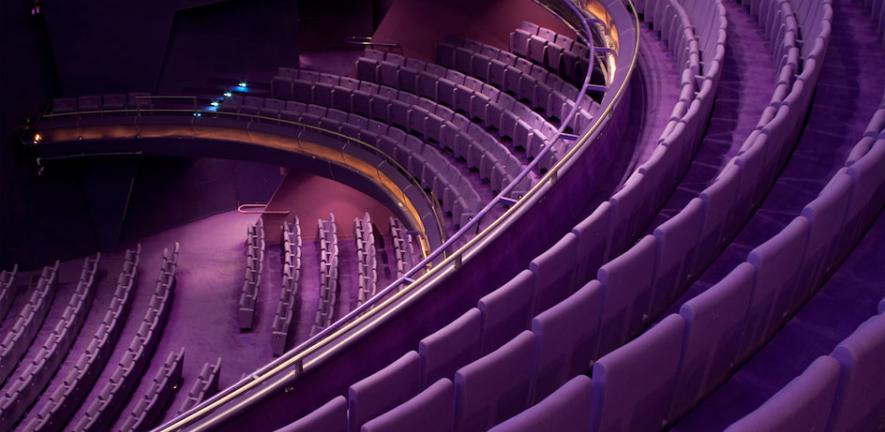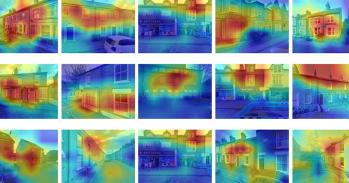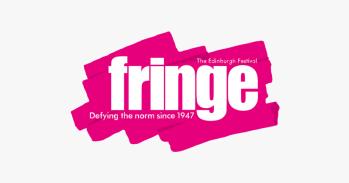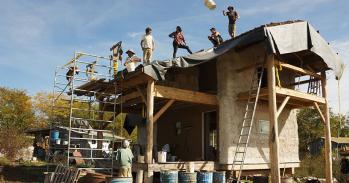
National recommendations for using public money to build arts venues are only succeeding in enforcing a system that is already flawed, a new study concludes.
National recommendations for using public money to build arts venues are only succeeding in enforcing a system that is already flawed, a new study concludes.
The design of buildings for the arts is never going to be straightforward or quick but the standard process punishes innovation and promotes delivery over budget and behind schedule.
Professor Alan Short
Serious flaws at the heart of creating buildings for the arts have been uncovered by a recently published research project, which also throws a spotlight on the disillusionment and loss of faith felt by individuals involved in such projects.
The study, described in the book Geometry and Atmosphere, questions the validity of the current system used for major theatre refurbishing and buildings projects – a system that the National Audit Office (NAO) recommends should actually be reinforced to address the problem that new buildings are frequently over budget and damagingly late.
Instead, say the researchers, the entire process should be rethought. Distilling their findings into new guidance for the many stakeholders – architects, designers, administrators, engineers and builders – the researchers provide insight that will be useful to any sector where public money is spent on major building projects. Such guidance, they believe, will transform the process from one that is ‘corrosive’ to one that is inspirational for all those involved.
Focusing on the construction and financial histories of six prominent theatres, the project led by Professor of Architecture at the University of Cambridge, Alan Short, in conjunction with the University of Salford, conducted an exhaustive investigation into all areas of the design, procurement and delivery process. The three-year research project was funded by the Arts and Humanities Research Council.
“This is an angry community with a lot to say,” said Short. “One experienced administrative director vowed she would, ‘never, never, never do a building again, because it is just too stressful’, and a Director declared that ‘Arts buildings are seriously bad for your artistic health’.
“Such was the intensity of feeling that virtually every participant was extraordinarily candid. What emerges is a labyrinthine and often corrosive capital project process that courts problems and in some cases even leads to complete failure.”
More than £1 billion has been spent by the Arts Council of England Lottery Fund, much of it on buildings. A report by the NAO in 1999 on 15 Lottery-funded projects revealed that 12 were over budget and seven were damagingly late. Their recommendation was for greater enforcement of the standard project management protocols of sequential ‘work stages’ and no going back on design decision-making later in the process.
With unprecedented access to stakeholders, their archives and records – from day-to-day project correspondence to Board meeting minutes and confidential briefing notes – the researchers sought to understand why so many projects had proved problematic.
“After the NAO was unrestrained in its criticism of all those involved in the procurement of arts capital projects, they effectively ‘criminalised’ large sectors of the arts, design and construction communities as negligent in the use of public funds,” said Short. “But our results question the likely effectiveness of the NAO’s astringent recommendations.”
The project reveals that clients for arts projects had little or no idea what was coming as they entered the convoluted UK construction process. “Unlike the arts world, which runs on goodwill and the ingrained ethic of getting the show open on the night, the construction industry conscientiously claims remuneration for every act it performs, charging heavily for reiteration and extensions of time,” explained Short.
In addition, the researchers highlight that the Arts Council Lottery organisation’s process allows relatively little time to conjure up ambitious visions to catch the Lottery panel’s eye, with the result that bidders are gambling with sketchy ideas unproven technically but, when successful, are absolutely tied to the original budget figure.
By the time the very necessary technical expertise becomes affordable it is inevitable that it is disruptive; acousticians, environmental and structural engineers, and technical theatre consultants, often find that there is no budget to absorb their necessary changes.
Through mapping the progress of the budget variance against the authorised budget for each theatre project, the team revealed that all project bids were completely different, calling into question the use of a standard ‘one-size-fits-all’ template for realising arts capital projects.
Instead they propose a modified procurement protocol. First, expressions of interest outlining the vision should be solicited and reviewed; those permitted to proceed would receive enough funding to develop a credible technically secure design; detailed schemes would then be reviewed intensively, some sent back for reiteration, some cancelled, but others permitted to proceed to full construction information, again properly resourced; finally, a rolling technical review would enable rapid construction to start in order to preserve teams and project expertise.
As attention focuses on the true cost of staging the 2012 Olympics, and the merits are debated of building new schools, colleges and hospitals, the findings described in the book provide new evidence on which to base practices needed to deliver successful capital projects.
“The design of buildings for the arts is never going to be straightforward or quick but the standard process punishes innovation and promotes delivery over budget and behind schedule,” added Short. “With the publication of Geometry and Atmosphere, we hope that our findings will provide practical guidance for stakeholders involved in all parts of major building projects.”
Alongside the book, a film has been made to accompany the project (www.sms.cam.ac.uk/media/1095045).
This work is licensed under a Creative Commons Licence. If you use this content on your site please link back to this page.





